Haughley Park
Haughley Park House in Stowmarket, Suffolk is an historical house of significance listed in the English Heritage Register.[1] It is a large red brick country house built in about 1620 for the Sulyard family who were very prominent landowners in this area. The property remained with this family for two centuries after which it was sold. Today it is a private residence but at certain times of the year the gardens are open for viewing. The barn and gardens are also available for weddings.
.jpg)
The Sulyard family
The site of a royal hunting ground attached to Haughley castle, the land was granted by Henry VIII to Charles Brandon Duke of Suffolk who later surrendered it to the Crown. The land was then granted to Sir John Sulyard by Queen Mary because of the loyalty he had shown when she was deposed. John was a staunch catholic and Lord Chief Justice of England's and the only existing painting of him in the Palmer Family Collection shows him to be a formidable character. The house was subsequently built in the reign of King James I and generations of Sulyards lived there until the end of the 18th century.[2] The last male heir was Edward Sulyard (1744-1799). Although he married twice he had no sons and when he died in 1799 he left his property to his three daughters.
The Jerninghams
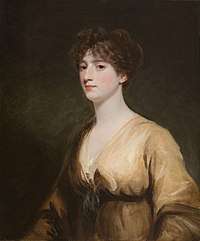
One of Edward Sulyard's daughters Frances, married George Jerningham eldest son and heir of Sir William Jerningham of Costessey Hall in Norfolk. Francis Sulyard (Fanny) was very much admired and loved by George Jerningham. He wrote several letters about his admiration. Shortly after his engagement to her in 1799 he visited the Sulyard family at Haughley Hall and wrote a letter to his sister from this house. He describes his future bride in the following terms.
I got to this Mansion on Wednesday and met with a most friendly reception. It is impossible for me to say how much I was struck with my Lady's appearance, she so infinitely surpasses in every way all I had figured to myself, from the few times I had seen her, and (as I wrote my Mother word the other day) when I look at her I can scarcely believe I had had the happiness to please so beautiful and charming a woman. My fears before I came were, that her good opinion of me, might be lessened by further acquaintance, but I have every reason to hope that is not the case. Receive my most grateful thanks, for the very kind part you have acted throughout this business, and also for the good character you give me in your letters to her, which she showed me. It also gives me great satisfaction to find that her conduct is approved of by almost everyone, even intimate friends, who all agree it was absurd to expect so handsome a young woman to throw away any more of her time in useless waiting. I think if possible, she is still more handsome in the morning, than by candle light, which is rather uncommon with the modern belles.[3]
Shortly after this letter was written Frances's father Edward died and left Haughley Park and his estate to his three daughters. Frances married George Jerningham a few months after her father's death and the couple decided to live at Haughley Park for the next decade. Soon after their marriage George commissioned the famous painter John Hoppner to paint Frances's portrait. He wrote to his sister about this occurrence and his letter revealed that he still adored his wife.
Fanny is setting for her picture to Hoppner for my Father, a half length, 30 Guineas. Wood the Miniature Painter has done her also for me, tolerably well, but it is very difficult to make a good picture of so handsome a person. There is certainly at present no woman in town as handsome as she is, Miss Jennings, the celebrated beauty, not excepted.[4]
The portrait of Frances that was painted by John Hoppner is shown.
The couple lived at Haughley Hall until 1809 when George inherited his father's title and estate. They moved to the Jerningham family seat of Costessey Hall and Frances lived there for the rest of her life.
The Crawford family
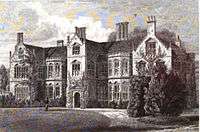
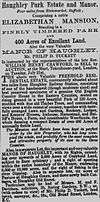
William Crawford (1756-1835) bought Haughley Hall in about 1816. He was born in 1856 and in 1880 he married Elizabeth Dorothea Cowley who was the daughter of Reverend Francis Lawrence Cowley. At the time of his marriage he lived at St James Westminster.[5] The couple lived in London for many years and had five children – two boys and three girls. In 1792 Thomas inherited a very large fortune from Jane Calmel who was a spinster and owned a large amount of land in London.[6]
Her brother Peter Calmel had died two years previously and named "William Crawford" and "Elizabeth Dorothea Crawford" in his will, leaving them annuities. When he bought Haughley Hall William Crawford was sixty and he came to the house accompanied by his wife and two unmarried daughters Elizabeth (1786-1861) and Harriet (1794-1858). He made some alterations to the building. An engraving of the Hall in 1827 is shown. His eldest son Thomas who was to be his heir died in 1830 so his younger son William Henry who had since become a clergyman inherited the estate in 1835 when he died.
The Reverend William Henry Crawford (1791-1868) lived at the hall with his two unmarried sisters for many years. Then in 1853 at the age of 62 he married Laura Taylor the daughter of a clergyman who was 35 years his junior.[7] William died in 1868 and left in his will some generous bequests to several charities. The Hall was placed on the market in the same year. The sale notice is shown.
The Pretyman family
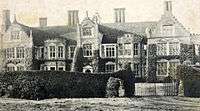
Arthur Charles Pretyman (1830-1898) bought Haughley in 1868 and lived there until his death thirty years later. Arthur was born in 1830 in Winchester. His father was Reverend George Thomas Pretyman who was the Chancellor of Lincoln. In 1858 he married Mary Baxter who was the heiress of Henry Baxter of Idvies, an estate in Scotland. Arthur was a military man and rose to the rank of Captain in the 25th Regiment. He also did some service in India.[8]
The couple had four children – one son and three daughters. His son Frederic Henry Pretyman (1875-1939) inherited the property when Arthur died in 1898. In 1917 he married Ethel Sparke, the daughter of Edward Bowyer Sparke who owned Gunthorpe Hall in Norfolk. Soon after this he put Haughley Park on the market.
20th century owners
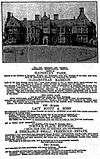
The property was bought in 1924 by Turner Henderson who was the second son of John Henderson owner of Studley Priory in Oxfordshire. Turner was born in 1876 and in 1914 he married Constance Pauncefort Duncombe the daughter of Sir Philip Henry Pauncefort Duncombe.[9] The couple had no children.
In his obituary Turner is described as "a farmer, explorer and big game hunter.[10] When he died in 1956 he left Haughley Park to the Zoological Society to be used as a zoological establishment but they declined his offer.
Instead Alfred Williams bought the Park to be used as for his poultry processing business. A devastating fire in 1961 gutted some of the house. However it was fully restored by the family three years later. The poultry business was sold but the Williams family still retain ownership of the Park.[11]
In 2019, plans to build new homes on the former poultry processing site were rejected by the local authority. [12]
References
- Historic England. "Haughley Park (1181268)". National Heritage List for England. Retrieved 1 October 2015.
- Copinger, Walter 1905 The Manors of Suffolk
- Frances Dillion Jerningham, The Jerningham letters (1780-1843), p. 153.
- Frances Dillion Jerningham, The Jerningham letters (1780-1843), p. 188.
- Marriage Bond 1780. Reference No. DL/A/D/24/MS10091E/93
- Cornwell Council, Will of Jane Calmel
- The Gentleman's Magazine, 1853, p. 403.
- Obituary of Arthur Charles Pretyman, The Bury and Norwich Post, and Suffolk Standard, 18 June 1898; pg 5.
- The Peerage
- The Times (London), 1 February 1957; pg. 10
- "Haughley Park website". Archived from the original on 2011-12-19. Retrieved 2014-08-04.
- Jefford, Will. "'Unsustainable' bid for 149 houses near stately home is rejected". East Anglian Daily Times.